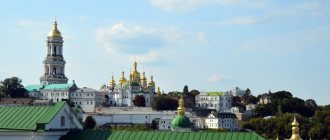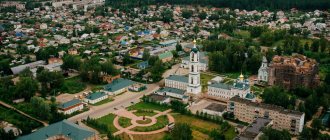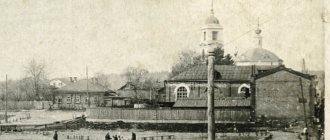| Ust-Kamenogorsk diocese Russian Orthodox Church | |
St. Andrew's Cathedral in Ust-Kamenogorsk | |
| basic information | |
| A country | Kazakhstan |
| Square | 283.3 thousand km² |
| Population | 1 396 746 |
| Diocesan center | Ust-Kamenogorsk |
| Founded | October 5, 2011 |
| Number of parishes | 36[1] |
| Number of clergy | 28 |
| Cathedral Church | St. Andrew's Cathedral (Ust-Kamenogorsk) |
| Sanctification of the ruling bishop | Bishop |
| Title of the ruling bishop | Ust-Kamenogorsk and Semipalatinsk |
| Website | [vko-eparhia.kz/vko-eparhia.kz] |
| Bishop | |
| Ruling bishop | Amfilohiy (Bondarenko) |
| With | February 26, 2012 |
Ust-Kamenogorsk and Semipalatinsk diocese
- diocese of the Kazakhstan Metropolitan District of the Russian Orthodox Church. Unites parishes within the East Kazakhstan region of the Republic of Kazakhstan.
Story
From 1911 to 1955 there was an episcopal see (until 1923 - a vicar) in Semipalatinsk. In 1928-1937 it was called Semipalatinsk and Ust-Kamenogorsk, in 1947-1955 Semipalatinsk and Pavlodar[2].
The Ust-Kamenogorsk diocese was established on October 5, 2011, having been separated from the Pavlodar diocese. Archbishop Gabriel (Steblyuchenko) has been appointed to be the diocesan bishop[3].
On December 27, 2011, by the decision of the Holy Synod, Archbishop Gabriel was retired, and Abbot Amfilokhiy (Bondarenko), a clergyman of the Astana diocese, was elected as the new administrator of the diocese[4].
History of the diocese
The Pavlodar diocese of the Kazakhstan Metropolitan District of the Russian Orthodox Church was formed by decision of the Holy Synod on October 6, 2010 within the Pavlodar and East Kazakhstan regions of the Republic of Kazakhstan as the Pavlodar and Ust-Kamenogorsk diocese by separating from the Astana and Almaty diocese. The Bishops' Council of the Russian Orthodox Church on February 2-4, 2011 approved this decision. After the separation, by definition of the Synod of October 5-6, 2011, from the Pavlodar diocese of the Ust-Kamenogorsk diocese, the title of the bishop was changed to “Pavlodar and Ekibastuz”.
Photo album “History of Orthodoxy in the Pavlodar Irtysh region”
The borders of the diocese coincide with the borders of the Pavlodar region of the Republic of Kazakhstan. Cathedral city – Pavlodar. Cathedral - Pavlodar in honor of the Annunciation of the Blessed Virgin Mary. The ruling bishop is Bishop Varnava (Safonov; since November 14, 2010).
The diocese is divided into 3 dean districts: Pavlodar (Pavlodar, Akkul, Pavlodar, Uspensky and Shcherbakty districts), Ekibastuz (the cities of Ekibastuz and Aksu with rural regions, as well as Bayanaul and May districts) and Terenkol (Terenkol, Aktogay, Zhelezinsky and Irtysh areas).
Currently, there are 23 parishes in the diocese (18 independent and 5 affiliated) and the Peter and Paul Convent. The clergy of the diocese consists of 23 priests and 4 deacons. The diocesan administration has departments: education and catechesis, social ministry, prison ministry, information and publishing. The diocese also operates: a commission for the canonization of saints, a disciplinary commission, a trustee commission and a pilgrimage service.
Since 2002, the monthly newspaper “Blagoveshchenie” has been published, which after the formation of the Pavlodar diocese received diocesan status. There is an official website of the Pavlodar diocese.
Orthodoxy on the land of the Pavlodar Irtysh region
In the 18th century, in the southwest of Siberia and the northeast of Kazakhstan, a system of Russian defensive lines of fortresses, outposts and redoubts, as well as a system of military-industrial, military-administrative, trade and economic centers began to be created. In 1715, an expedition under the command of Lieutenant Colonel I.D. Buchholz founded the Yamyshevskaya fortress (now the village of Yamyshevo) in a tract near the Yamyshevsky salt lake (now Lake Kalatuz) to protect against nomads. In 1717, the Zhelezinskaya fortress (now the village of Zhelezinka) was founded between the Omsk fortress and Yamyshevskaya. To ensure communication between the fortresses, intermediate outposts were built: Osmoryzhsky, Chernoretsky, Koryakovsky and others. Subsequently, fortresses and outposts lost their military significance and were transformed into villages and villages. Thus, in 1838, the Koryakovsky outpost became a village, which in 1861 received the status of a provincial town with the name Pavlodar. In 1868 the city became the district center of the Semipalatinsk region. In 1938, the Pavlodar region was formed with its center in Pavlodar.
The construction of temples in the Pavlodar Irtysh region was carried out simultaneously with the creation of fortresses and outposts, and the development of the territory of the Pavlodar Irtysh region by the Russian population. The number of Orthodox Christians especially increased as a result of the massive resettlement of peasants from internal Russian provinces during the Stolypin agrarian reform of the early 20th century.
In the 18th - 1st half of the 19th centuries, parishes on the territory of the Pavlodar diocese belonged to the Siberian and Tobolsk diocese (from October 5, 1768, Tobolsk and Siberian). In 1832 (according to other sources in 1854), the churches on the territory of the current Pavlodar diocese were assigned to the Tomsk diocese formed in 1832 (from May 25, 1861, Tomsk and Semipalatinsk). In 1895, the parishes of Pavlodar district became part of the newly formed Omsk diocese (in 1913-1943 (according to other sources in 1913-1937) it was called Omsk and Pavlodar).
In the Yamyshevskaya fortress in the 20s of the 18th century, a wooden church was built in the name of the Apostle and Evangelist John the Theologian, and in 1782-1783 a stone church with two chapels was consecrated: in the name of St. Nicholas and St. Demetrius of Rostov. In the Zhelezinsky fortress by 1751 there was a wooden church in the name of the All-Merciful Savior. In 1765 it burned down. In 1772, a new wooden church was consecrated, and in 1793, the consecration of a stone church built next to the wooden chapel in honor of the Kazan Icon of the Mother of God took place. In 1801, a stone church was consecrated here in honor of the Holy Life-Giving Trinity, and later another chapel church was built in the name of St. Nicholas the Wonderworker. In 1824, the construction of the single-altar Prophet Elijah Church in the Peschansky outpost (now the village of Peschanoe, Terenkol region) was completed.
One of the first buildings of the Koryakovsky outpost, founded in 1720, was a small Cossack church. In 1841, in the village of Koryakovskaya, a wooden Floro-Lavra Church was erected, which burned down in 1901. In 1868, the stone St. Stephen's Church was consecrated in the village of Bayan-Aulskaya (now the village of Bayanaul). In 1893, a church was built in Pavlodar, which was first assigned to the Floro-Lavra Church, and in 1902 received the status of a cathedral in the name of the Holy Trinity. In con. In the 19th century, the Resurrection Church was built at the city cemetery of Pavlodar, and in 1910, on the site of the burnt Floro-Lavra Church, the foundation stone of the Vladimir Cathedral took place, the construction of which was interrupted by the First World War and the revolution.
In the 70s of the 19th - early 20th centuries, the following were built: in 1870, a wooden church in the name of the Archangel Michael in the village of Urlyutyupskaya (now the village of Urlyutyub, Zhelezinsky district), in 1875, a wooden church in the name of the Apostle and Evangelist Matthew in the village of Chernoretskaya (now Chernoretsk village, Pavlodar district), in 1881-1885, a wooden church in the name of the apostles Peter and Paul in the village of Pyatoryzhsk (now the village of Pyatiryzhsk, Zhelezinsky district), in 1881-1887, a wooden church in the name of St. Nicholas the Wonderworker in the village of Chernoyarsk (now the village Chernoyarka, Pavlodar district), in 1906-1908, a stone church in the name of St. Nicholas the Wonderworker in the village of Osmoryzhsky (now the village of Osmeryzhsk, Terenkolsky district), in 1908, a wooden Trinity Church in the village of Lebyazhinsky (now the village of Akkuly, Akkuly district), in 1909-1910 a wooden church in the name of the Holy Trinity in the village of Alexandrovskoye (now the village of Alexandrovka, Shcherbaktinsky district), in 1912-1914 a stone church in the name of the blessed prince Alexander Nevsky in the city of Irtyshsk (formerly the village of Krasny Yar, now the village of Irtyshsk, Irtysh district), in 1914 a wooden church in the name of the Great Martyr George the Victorious in the village of Gavrilovsky (later the village of Gavrilovka, Pavlodar region, now does not exist), in 1913-1916, a stone church in the name of St. Nicholas the Wonderworker in the village of Ermak (now the city of Aksu). At the beginning of the 20th century, houses of worship were opened in many settlements of Pavlodar district.
In 1895-1917, on the territory of the present Pavlodar diocese, a missionary camp of the Kyrgyz spiritual mission operated, which was first located in the village of Chernoyarsk, and in 1907 was moved to the village of Aleksandrovsky, Pavlodar district. The Memorial Book of the Semipalatinsk Region for 1898 also mentions the Bayan-Aul camp.
With the establishment of Soviet power, the process of closing churches and houses of worship began, church buildings were transferred to house cultural and economic institutions.
In the 2nd half of the 30s, the Resurrection Church was destroyed and the Trinity Cathedral in Pavlodar was dismantled into bricks. Many other temples were destroyed. By the end of the 30s of the 20th century, not a single church was operating in the Pavlodar Irtysh region, there were no registered parishes. The Omsk department was widowed from 1937 to 1946.
In the 30s of the twentieth century, the Pavlodar Irtysh region became a place of exile for many convicted clergy, monastics and laymen. In 1937-1938, many of them were re-arrested and shot. There are several investigative cases opened against Orthodox believers in the Pavlodar Irtysh region. Among the new martyrs and confessors glorified by the Bishops' Jubilee Council of the Russian Orthodox Church in 2000 are the names of 24 believers who died on the lands of the Pavlodar Irtysh region. They constitute the Council of the New Martyrs of Pavlodar. Every year on November 28 (November 15, Old Art.), on the day of church remembrance of the Hieromartyr Peter (Konardov) and the Martyr Gregory (Dolinin), the Pavlodar diocese commemorates the Council of the New Martyrs of Pavlodar. On this day, the Divine Liturgy is celebrated in the cathedral church by the council of clergy of the Pavlodar diocese and a procession of the cross.
In 1948, the territory of the current Pavlodar diocese became part of the Semipalatinsk and Pavlodar diocese, which, after liquidation in 1937, was resumed by separating the territory of the Semipalatinsk, Pavlodar and East Kazakhstan regions from the Tashkent and Central Asian diocese. In 1955, the Semipalatinsk and Pavlodar diocese was liquidated, and its territories were included in the Alma-Ata and Kazakhstan diocese (until 1991), then in the Almaty and Semipalatinsk (1991-1999) and Astana and Almaty (1999-2010). ).
In 1944, after believers appealed to the authorities, the Nativity of Christ Orthodox community was registered in Pavlodar and provided with a house of worship. In 1945 - early 50s, a parish and prayer house in the name of the blessed Prince Alexander Nevsky operated in the village of Irtyshsk. In 1978, a community was registered in Ekibastuz and a prayer house was purchased, which on October 1 of the same year was consecrated in the name of St. Seraphim of Sarov.
In the 90s of the 20th century, the construction of churches and the opening of parishes intensified in the Pavlodar Irtysh region. In 1999, construction was completed in Pavlodar and the consecration of the Annunciation Cathedral took place, which received the status of a cathedral. Also in the 90s of the 20th century, churches were built and consecrated: in the name of the Life-Giving Trinity in the village of Zhelezinka, Trekhsvyatitelsky in the village of Kachiry (now Terenkol), in the name of All Saints who shone in the Russian land in the village of Solnechnoye; prayer houses were opened in the city of Aksu, the villages of Aktogay, Zhambyl, Irtyshsk, Konstantinovka, Pavlodarskoye, Uspenka, Shcherbakty, and the village of Leninsky. In 2000, the Iversko-Seraphim Cathedral in Ekibastuz was consecrated. In 2003, the Resurrection Church in Aksu and the Assumption Church in the village of Uspenka were built.
Temple construction continued after the formation of the Pavlodar diocese: in 2015, the Trinity Church-chapel was erected in the village of Aleksandrovka on the site of the Trinity Church destroyed in the 30s of the 20th century, in 2021 the construction of the temple in the name of Archangel Michael in Pavlodar was completed, in 2021 Ioanno was consecrated -Predtechenskaya Church in the village of Orlovka, Shcherbaktinsky district. The restoration of the destroyed temple in the name of the blessed prince Alexander Nevsky in the village of Irtyshsk is being completed.
Links
other countries Argentine • Baku • Berlin • Brussels • Budapest • Vienna • Vilna • The Hague • Korsun • Sourozh Autonomous churches Chinese PC Beijing • Xinjiang • Tianjin • Harbin • Shanghai Japanese PC Kyoto • Sendai • Tokyo Self-governing churches Ukrainian PC Alexandria • Baltska • Belotserkovskaya • Berdyansk • Boryspilska • Vinnitsa • Vladimir-Volynska • Voznesenskaya • Volynska • Gorlovska • Dzhankoyska • Dnepropetrovsk • Donetsk • Zhytomyr • Zaporozhye • Ivano-Frankivsk • Izyumska • Kamenets-Podilska • Kamenska • Kyiv • Kirovograd • Konotop • Kremenchug • Krivoy Rog • Luhansk • Lviv • Mogilev-Podolsk • Mukachevo • Nizhyn • Nikolaev • Novokakhovsk • Ovruch • Odessa • Poltava • Rivne • Rovenkovsk • Romensk • Sarnensk • Severodonetsk • Simferopol • Sumy • Ternopil • Tulchin • Uman • Feodosia • Kharkov • Kherson • Khmelnitsky • Khust • Cherkasy • Chernihiv • Chernivtsi • Shepetovsk
Human Rights Center of Moldova Beltsy • Edinet • Cahul • Kishinevskaya • Tiraspol • Ungheni
Latvian PC Daugavpilsskaya • Rizhskaya Estonian Human Rights Center Narvskaya • Tallinskaya ROCOR Berlin • British • East American • Geneva • Montreal • San Francisco • Sydney • Chicago • South American Exarchates Belarusian Exarchate Bobruisk • Borisov • Brest • Vitebsk • Gomel • Grodno • Lida • Minsk • Mogilev • Molodechno • Novogrudok • Pinsk • Polotsk • Slutsk • Turov
Metropolitan districts Kazakhstani Astanaiskaya • Karaganda • Kokshetau • Kostanay • Pavlodar • Petropavlovsk • Ural • Ust-Kamenogorsk • Chimkent
Central Asian Bishkek • Dushanbe • Tashkent • Patriarchal parishes in Turkmenistan
Patriarchal parishes of the Moscow Patriarchate Italy • Canada • USA • Finland
Holy Protection Parish of the Ust-Kamenogorsk and Semipalatinsk Diocese
Categories of enterprises and services
Category: Ust-Kamenogorsk Holy Protection Church
Address: Ust-Kamenogorsk, pos. Mirny, st. Akmolinskaya, 110 Travel by bus No. 42, No. 13 stop Church Tel., 8 (7232) 781-524 Email: Alexey Anishchenko www.blago-pokrov.kz
Update date: 02/03/2021
Print Write to us
On the map
"Holy Protection Parish of the Ust-Kamenogorsk and Semipalatinsk Diocese"
The temple is open to parishioners daily from 8-00 to 18-00, and on HOLIDAYS until 19-00; during the night services of Holy Easter, Nativity of Christ, Epiphany - around the clock.
LITURGY in the Holy Protection Church, and on the eve of it, evening services are performed weekly on Saturdays and Sundays, as well as all Great Weeks, holidays, Days of Remembrance of revered saints and polyeleos services.
During the first week, Holy Week of Great Lent and Easter week, statutory services are held daily.
Time of services: prayer service 8-00, reading hours from 8-40, Divine Liturgy at 9-00, evening service 16-00 (in the summer from Antipascha to the Feast of the Intercession of the Blessed Virgin Mary);
15-00 (in winter). We call on philanthropists, philanthropists, businessmen, entrepreneurs, parishioners and simply caring people to provide all possible charitable assistance to maintain the viability of our Holy Protection parish (Mirny village) and improve the territory.
Today, not enough funds have been collected for the entire range of work. We really count on your support and help. The complex of works will include planning, paving with paving stones, and landscaping with cultural plantings. Donations can be made through the registrar of the icon shop (with a record of the names you proposed for prayerful remembrance for health and repose). We hope for your mercy and understanding. We will be glad to receive any possible help.
We invite you to visit our parish, which we believe, with your help, will become a decoration of our city.
You can transfer your donations
MPRO "Ust-Kamenogorsk Holy Protection Parish" of the Ust-Kamenogorsk and Semipalatinsk Diocese
KZ41914102203KZ000LY
BIN 911240000940 SB Sberbank JSC
BIC SABRKAZKA
KBE 18
Bank BIN 930740000137
If it is impossible to visit the temple to submit a record of the names you proposed for prayerful remembrance for health and repose, WE OFFER you to send information to WhatsApp +7 708 673 3243 Kirill and transfer donations to the Caspian Gold card account 5169 4931 3998 6189 Alexey Anishchenko
On the map
Excerpt characterizing the Ust-Kamenogorsk diocese
- And it’s impossible otherwise? – she asked. Prince Andrei did not answer, but his face expressed the impossibility of changing this decision. - It's horrible! No, this is terrible, terrible! – Natasha suddenly spoke and began to sob again. - I will die waiting a year: this is impossible, this is terrible. “She looked into the face of her fiancé and saw on him an expression of compassion and bewilderment. “No, no, I’ll do everything,” she said, suddenly stopping her tears, “I’m so happy!” – Father and mother entered the room and blessed the bride and groom. From that day on, Prince Andrei began to go to the Rostovs as a groom. There was no engagement and Bolkonsky’s engagement to Natasha was not announced to anyone; Prince Andrei insisted on this. He said that since he was the cause of the delay, he must bear the entire burden of it. He said that he was forever bound by his word, but that he did not want to bind Natasha and gave her complete freedom. If after six months she feels that she does not love him, she will be within her right if she refuses him. It goes without saying that neither the parents nor Natasha wanted to hear about it; but Prince Andrei insisted on his own. Prince Andrei visited the Rostovs every day, but did not treat Natasha like a groom: he told her you and only kissed her hand. After the day of the proposal, a completely different, close, simple relationship was established between Prince Andrei and Natasha. It was as if they didn't know each other until now. Both he and she loved to remember how they looked at each other when they were still nothing, now both of them felt like completely different creatures: then feigned, now simple and sincere. At first, the family felt awkward in dealing with Prince Andrei; he seemed like a man from an alien world, and Natasha spent a long time accustoming her family to Prince Andrei and proudly assured everyone that he only seemed so special, and that he was the same as everyone else, and that she was not afraid of him and that no one should be afraid his. After several days, the family got used to him and, without hesitation, continued with him the same way of life in which he took part. He knew how to talk about the household with the Count, and about outfits with the Countess and Natasha, and about albums and canvas with Sonya. Sometimes the Rostov family, among themselves and under Prince Andrei, were surprised at how all this happened and how obvious the omens of this were: the arrival of Prince Andrei in Otradnoye, and their arrival in St. Petersburg, and the similarity between Natasha and Prince Andrei, which the nanny noticed on their first visit Prince Andrei, and the clash in 1805 between Andrei and Nikolai, and many other omens of what happened were noticed by those at home. The house was filled with that poetic boredom and silence that always accompanies the presence of the bride and groom. Often sitting together, everyone was silent. Sometimes they got up and left, and the bride and groom, remaining alone, were still silent. Rarely did they talk about their future lives. Prince Andrei was scared and ashamed to talk about it. Natasha shared this feeling, like all his feelings, which she constantly guessed. One time Natasha started asking about his son. Prince Andrei blushed, which often happened to him now and which Natasha especially loved, and said that his son would not live with them.





